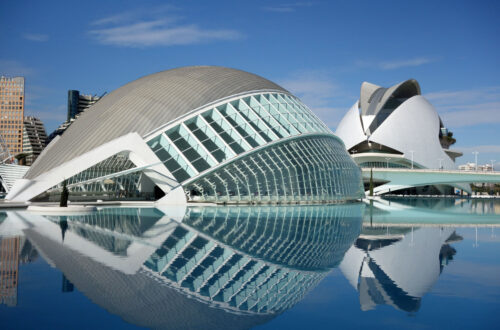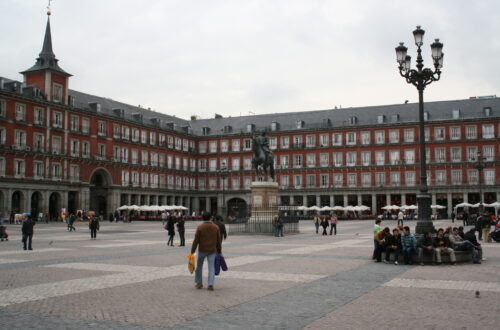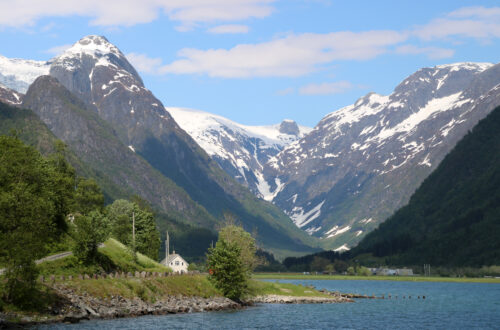
Andalusia, Spain
Itinerary: Seville – Cordoba – Granada – Ronda – Seville
When you think of the south of Spain, you probably think of the Costa del Sol and the mass tourism in cities such as Malaga and Torremolinos. But southern Spain is more than mass tourism. For the more culturally and historically minded traveler, in the interior of Andalusia the cities of Seville, Cordoba, Granada and Ronda await, which can easily be combined into a multi-city trip by train and bus.
The autonomous region of Andalusia breathes history. The name is derived from the Arabic al-Andalus and the region owes that name to eight centuries of Moorish rule. In 711 CE, Muslims from North Africa conquered the south of the Iberian Peninsula and later the rest of what is now Spain and Portugal. The Moors brought decorative and high-quality Arabic architecture to al-Andalus, at that time the westernmost part of the Arab world. Many of the famous sights in Andalusia, such as the Alhambra in Granada, the Mezquita in Cordoba and the Réal Alcazar in Seville date from that time.
In the thirteenth century, armies led by the Kingdom of Castile conquered first Cordoba and then Seville. The Emirate of Granada would last until 1492, but after that the Moorish rule was over and the Reconquista, the reconquest of the Iberian Peninsula by the Christians from the Muslims, a fact. After the Reconquista, the Muslim population was forced to convert to Catholicism or to leave and the Arabic language was banned. Nevertheless, eight centuries of Moorish rule can still be seen everywhere in Andalusia’s architecture today. A large part of the palaces, mosques and mansions has been preserved, often mixed with later, especially Gothic, architectural styles.
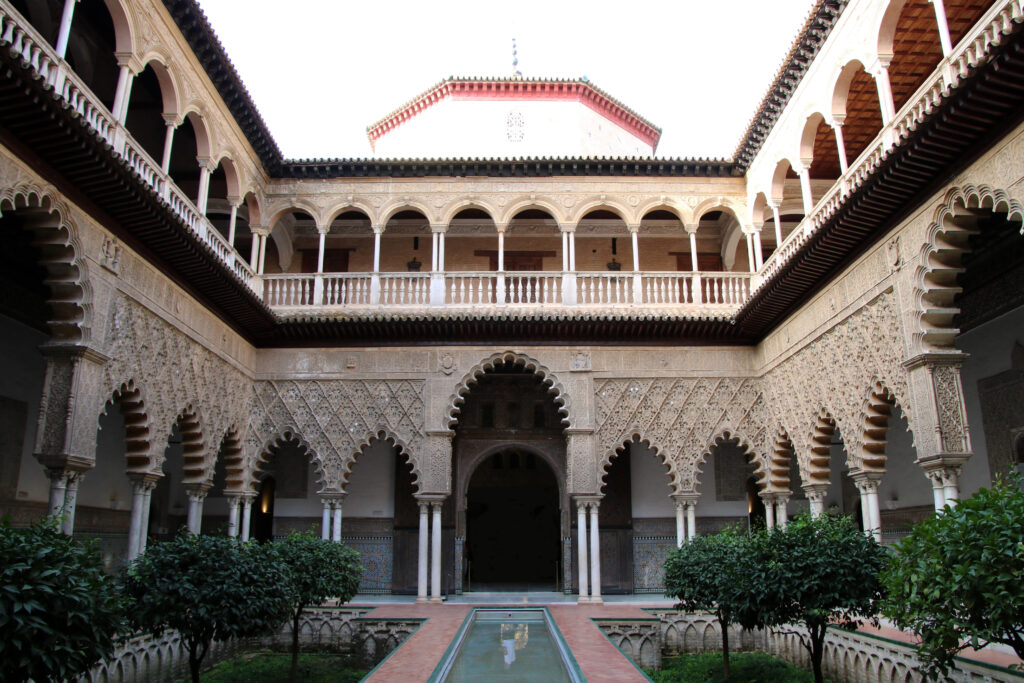
The discovery of the American continent by Columbus in 1492 and the subsequent conquest of large parts of Central and South America by Spain initially led to great prosperity in Andalusia, but an economic decline followed in the eighteenth and nineteenth centuries. Spain lost its colonies, trade dried up and Andalusia became impoverished. It was not until after the Spanish Civil War in the 1930s that the tide started to turn for Andalusia in the 1950s and 1960s, thanks to the rise of tourism on the Costa del Sol. The region also benefits from the modernization that Spain went through in the 1980s and 1990s after the death of General Franco in 1975 and the country’s transition to a democracy. Since 1982 Andalusia has been an autonomous region with Seville as its capital and it is there that I start my multi-city trip through Andalusia.
Seville
Seville (Sevilla in Spanish) has almost 700,000 inhabitants, making it the largest city I will visit in Andalusia. It’s a city with a rich history. Despite its location inland, Seville was in the past a port city, which was connected to the Atlantic Ocean thanks to the Guadalquivir river. In 1503, Seville was given a monopoly on trade with the new Spanish colonies on the American continent. This brought the city a lot of wealth. From the eighteenth century, the Guadalquivir became increasingly difficult to access due to salinization and trade moved to Cádiz. Today Seville is a bustling southern Spanish city that is popular with tourists.
On Monday evening around eight p.m. I land at Seville airport, about seven kilometers northeast of the city. By bus it’s half an hour to Santa Justa station, in the center of the city, from where it is a few minutes’ walk to my hotel. Having left drizzly autumn weather in the Netherlands, it turns out to be sunny and warm in Seville. Perfect weather to explore the city the next day. That starts with a long line at the entrance of the Real Alcázar, the former royal palace and one of the most popular sights in Seville.

The Real Alcázar started out as a fortress and has expanded over time into a magnificent palace complex. In the eleventh and twelfth centuries, the Arab rulers of Seville built their palaces there and after the conquest of Seville in the thirteenth century, the Catholic kings added their own palaces. The Puerta del León forms the entrance to the Real Alcázar and provides access to a patio of the same name. To its left is the Sala de la Justicia, a square room with carved walls and ceiling and a well in the middle.
Another gate leads to the Patio del Montería, a large courtyard dominated by the facade of the Palacio Don Pedro. Don Pedro was a Catholic king who maintained good relations with the Muslim emir of Granada. Thanks to that connection, Don Pedro was able to have a Mudéjar-style palace built that is considered one of the highlights of Arab architecture in Europe to this day. In the center of the palace is the Patio las Doncellas, a beautiful courtyard garden with a pond, surrounded by two floors of colonnades, with graceful arches and richly decorated and tiled walls. This also applies to the Alcoba Real, the royal residences.

Via the covered Patio de las Muñecas you arrive at the impressive Quarto del Príncipe, with a dizzying golden ceiling that depicts the starry sky. The architecture of the palace complex is truly stunning. Everywhere the walls are decorated and equipped with tiles with mosaics and Arabic texts, and horseshoe-shaped arches give access to yet other beautiful rooms with carved wooden ceilings and vistas. Perhaps the highlight of the Real Alcázar is the Salon de Embajadores, which exudes wealth. The arched gates that give access to this room, decorated with gold and mosaics, have a characteristic horseshoe shape. If you look up, you can see a beautiful dome whose motif represents the universe (because of its color, the dome is nicknamed the half orange).
Finally, you arrive at the gardens of the Alcázar, which includes a pond that began its existence as a swimming pool, and the Galería de Grutesco, a long colonnaded wall, overlooking the gardens. The gardens should be an oasis of calm, were it not for the fact that the entire Real Alcazar is extremely busy. That detracts a bit from the experience, but the palace complex is so much-visited for a reason. It is really impressively beautiful.

A short walk from the Real Alcázar, south of barrio Santa Cruz, is the Parque de María Luisa, a large, green urban park. In the middle of this park you will find one of the most beautiful squares I know: Plaza España. On the large semicircular plaza is a similarly large semicircular red brick building, built in 1929 for the Exposición Iberoamericana. The building has a colonnade from which you have a wide view over the square. On the ground floor are tile panels depicting the history of the various Spanish cities and regions. A canal runs in front of the building, which is spanned by several arched bridges. Those bridges are also decorated with tiling and blue and white balustrades. It’s a beautiful and very photogenic place.
I stroll through the Parque de María Luisa and then along the Guadalquivir (not a specifically nice part for a walk), where I pass the Torre del Oro. This defensive tower, built in the thirteenth century, was once part of the city wall of Seville. Next I walk back to barrio Santa Cruz, an atmospheric neighborhood with a maze of narrow streets with whitewashed houses, cast iron balconies, shops and many restaurants with terraces. The latter invite you, after all the impressions, to end this day in Seville with wine and tapas.

Unlike my first day in Seville, on Wednesday morning it’s cloudy and drizzly for a while. I start slowly and take the time for coffee and breakfast on a terrace in El Centro, the newer neighborhood north of historic barrio Santa Cruz. Here you will find Metropol Parasol, locally known as Las Setas (the mushrooms). This is a huge work of art, built in 2011 and intended to be large off-white umbrellas, but as the nickname suggests they kind of resemble large mushrooms. Underneath is a space for open-air events, but without events it looks a bit bare. Personally I’m not a fan of Las Setas.
A few minutes north of Metropol Parasol is the Alameda de Hércules, an elongated square, originally laid out in the sixteenth century. On the south side of the square are two Greek columns, said to be originals dating back more than two thousand years, topped by statues of Hercules and Julius Caesar. I stroll through narrow streets, where a striking number of cars squeeze through, while the streets are not really made for that. Via the picturesque square Plaza de San Lorenzo, I arrive at the Ayuntamiento, the town hall of Seville. Originally built in the sixteenth century, but extensively renovated in the nineteenth century. On the east side, the City Hall borders Plaza de San Francisco, with a richly decorated Renaissance-style facade. On the west side, the building faces Plaza Nueva.

After lunch I walk to the Plaza de Toros de la Real Maestranza. This is the largest bullring in Spain. It is also the oldest: the construction of the bullring started in 1761. Although I am opposed to bullfighting, I do visit the bullring, which can accommodate 14,000 people. From numbered stone benches (under a colonnade, sombre, or uncovered, sol) they look out over a large round sandy plain). A full arena should be impressive.
In the afternoon I walk back to my hotel. After having some dinner, it’s time to head to Santa Justa station. The train to Cordoba leaves at 7:30 p.m. The journey from Seville to Cordoba, by comfortable Avant train, takes about an hour. It’s already dark when I arrive in Cordoba, where in ten minutes I walk from the train station to my hotel.
Cordoba
Cordoba has more than 325,000 inhabitants and is therefore half the size of Seville. However, in the eighth century CE, Cordoba was the capital of the Arab al-Andalus and when the Caliphate of Cordoba was proclaimed two centuries later, it was the largest city in Western Europe. It is from this time that the main attraction of Cordoba dates: the Mezquita. The mosque is considered to be one of the most important Islamic buildings in the world and was one of the largest and most architecturally beautiful mosques at the time. The mosque opens its doors every day at half past eight and can be visited for free for the first hour.
In the sixteenth century, after the Moors were expelled from the Iberian Peninsula, the Catholic Church built a cathedral inside the mosque. The building, often referred to as the “mezquita-catedral”, has since then been a somewhat curious mixture of Islamic and Christian architecture. However, the original architectural style of the Mezquita predominates (fortunately). The interior of the mosque is characterized by a countless number of arches of red and white stone, two tiers one above the other, resting on pillars and together supporting the carved wooden roof. It is an architectural masterpiece and very photogenic.

Originally, the mosque had nineteen large doors that provided daylight, but these have been closed during later Christian renovations. Altars, chapels and all kinds of Christian images have also been added. The mihrab (the niche that indicates the direction of Mecca) is richly decorated and mosaics and the dome above it is impressive. On the north side of the mosque is the Patio de los Naranjos, a courtyard garden with orange trees and cypresses. This is also where the largest of the gateways to the Mezquita is located, the Puerta del Perdón, dating from the fourteenth century. Right next to it is the Torre Campanario, the mosque’s original minaret.
If you walk around the Mezquita, you come to the river Quadalquivir (indeed the same river that also flows through Seville). The river is spanned here by the sixteenth-century Ponte Romano, on the site of the Via Augusta, the route that connected Catalonia on the eastern side of the Iberian Peninsula with the Atlantic Ocean, since the first century CE. From the historic bridge you have a beautiful view of Cordoba.
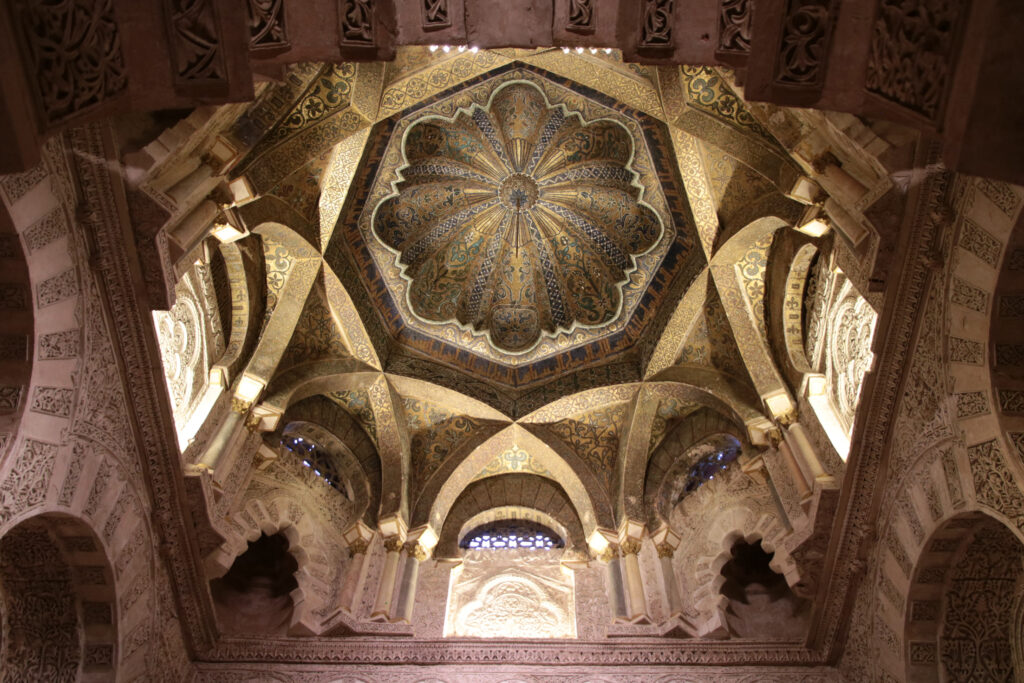
On the Quadalquivir is also the Alcázar de los Reyes Cristianos, the royal palace. Built in the fourteenth century, this was the palace where the Spanish king Fernando commissioned explorer Columbus to find a western sea route to India. The Alcázar stands on the edge of the Judería district, the heart of historic Cordoba. It’s a maze of narrow streets with mostly white plastered houses with cast iron balconies and tiled courtyards. Via the Plaza del Potro (small historic square with a fountain) I walk to the Plaza de la Corredera (large square surrounded by colonnade and red facades, somewhat reminiscent of Plaza Major in Madrid, but less beautiful) and finally to the Plaza de las Tendillas (a beautiful town square with a large fountain in the middle and surrounded by stately buildings. At the end of the afternoon it’s time for wine and tapas on the terrace of a small bodega.
Granada
It drizzles when I walk to Cordoba station on Friday morning, after an early breakfast. At half past eight the train leaves for Granada, two hours southwest of Cordoba. Granada has just under 230,000 inhabitants and is therefore much smaller than Seville and Cordoba. The city lies at the foot of the Sierra Nevada and was the last city to remain under Islamic rule until 1492, after cities such as Seville and Cordoba were conquered by the Christian kings in 1236 and 1248 respectively.
After a cup of coffee on a terrace on the Plaza de la Trinidad (a green park-square with a fountain and benches like you find in any Latin American village) I walk through the center of the city, which turns out to be surprisingly compact. What immediately strikes me is that it is a pleasant city, with many restaurants and tapas bars, all kinds of shops that often sell Arab and North African items, old buildings with beautiful facades, cozy squares with terraces, et cetera.

In the heart of the center is the immense cathedral, which from the outside looks almost like a fortress. Adjacent is the Capilla Real, the mausoleum where the last “reyes católicos” are buried. The mixture between Arab and Christian culture is also evident here, as next to the cathedral and the capilla is a fourteenth-century madrasse (now a university building). And just around the corner is the Alcaicería, the site of the old Moorish bazaar, now reduced to a few streets lined with souvenir shops. A little further is the Corral del Carbón, a fourteenth century trading town, where a beautiful horseshoe-shaped gate gives access to a courtyard with a well and vines.
Via the Plaza del Carmen, with the town hall of Granada, I pass a statue of Queen Isabel la Católica and the Plaza Santa Ana, with the beautiful building of the Tribunal Superior de Justicia de Andalucía. Then I walk towards the Albayzín district, the old Muslim quarter of Granada. The neighborhood is located against the hills, so the narrow streets with whitewashed houses rise here. The maze of streets eventually brings you to the Mirador San Nicolás. From here you have a magnificent view of the Alhambra, with the mountains of the Sierra Nevada in the background. After an extensive (and late) lunch on a terrace on the square next to the lookout point, I walk back to the center via the photogenic cobblestone streets of Albayzín.
The next morning, one of the highlights of the trip is on my itinerary: the famous Alhambra. The Alhambra, a corruption of ‘al-qala’a al-hamra’, which means the red castle, is the main Moorish landmark and one of the most beautiful Arab structures in Europe. The Alhambra once started its existence as a citadel. In the thirteenth and fourteenth centuries, this citadel was extended into the fortified palace complex you see today, and where the emirs of Granada resided. After the Reconquista, King Carlos V added a Renaissance palace – here too Arab and later Western architecture go hand in hand.

At eight a.m. I arrive at the Puerta de Justicia. This immense gate provides access to the grounds of the Alhambra (which are freely accessible) and is closer to the Alcazaba and the Palacios Nazaríes than the main entrance on the south side of the Alhambra. At half past eight the gate of the Alcazaba opens. This is the ruin of the original citadel and forms the westernmost part of the Alhambra. Early in the morning there is hardly anyone there and from the Torre de la Vela you have a panoramic view over Granada.
The highlight of the Alhambra are the Palacios Nazaríes, the palaces of the Moorish emirs. Access to the complex is limited to three hundred per hour and you must reserve a time slot for the Palacios Nazaríes. The complex consists of three parts: the Mexuar (the spaces for administrative affairs), the official and private quarters of the emirs, and the Palacio de los Leones, the private spaces of the emir and his family.
You first enter the Mexuar, with richly decorated walls, colored tiles and beautiful wooden ceilings. Then you enter the Patio del Cuarto Dorado, the first courtyard, with adjacent the Cuarto Dorado and directly opposite the Palacio de Comares. These spaces are also richly decorated with tiling, arches and ceilings. In addition to colored tiles with geometric shapes, there is also a lot of tile work with Arabic texts.

The second courtyard garden you come to is the Patio de los Arrayanes. This inner garden is the central place of the fourteenth century palace and has an elongated pond in the middle. On one side is the facade of the later built Palacio de Carlos V, on the other side you have a view of a tower in which the Salón de los Embajadores is located. Both the Sala de Barca and the Salón de los Embajaderos have richly carved wooden ceilings. In the Salón de los Embajaderos it’s a cedar dome with a star pattern here too (just in the Real Alcázar in Seville).
The Palacio de los Leones surrounds the central Patio de los Leones. This is a beautiful symmetrically built courtyard surrounded by slender columns and arches. In the center is a marble fountain surrounded by twelve – of course – marble lions. And just like in the Real Alcázar, every time you walk under a beautifully decorated gate, you enter a new impressive space. After the Patio de los Leones, this is the Sala de los Abencerrajes, with an impressive octagonal and domed ceiling. The walls in the Palacios are mostly of worked marble and panels with carvings. Everywhere you see richly decorated gates, arches, walls and ceilings, such as in the Sala de los Reyes and the Sala de Dos Hermanas. In the latter you look up at an impressive dome with a star pattern.
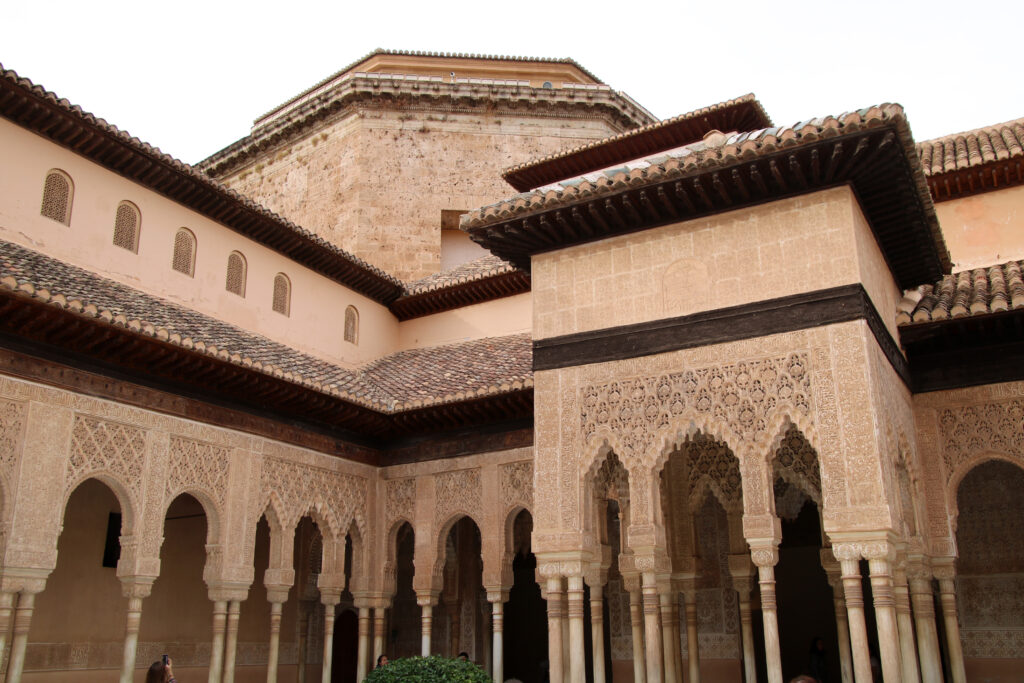
Via a few patios I eventually arrive at the Jardines del Partal, a garden named after the modest Palacio del Partal. From there I walk to the Palacio de Carlos V. This building is a great contrast to the Moorish architecture of the Palacios de Nazaríes. It’s a massive square building from the sixteenth century. Within the massive walls is a circular courtyard, surrounded by a lovely two-storey colonnade. The whole is still most reminiscent of an arena. Photogenic, but not as architecturally sophisticated as the Palacios de Nazaríes. In all, the Alhambra is very impressive. In the afternoon I take the time for a siesta, before I round off the day with wine and tapas.
Ronda
Monday morning I leave early for the train station of Granada. At a quarter past eight the AVE high-speed train leaves for Antequera Santa Ana, where I have to transfer (at the uninviting station) to the train to Ronda. Due to the long transfer, the journey takes three hours. Around noon I arrive in Ronda, where it is sunny and over 25 degrees.
Ronda has just under 34,000 inhabitants and is therefore significantly smaller than the cities where I was before. Ronda is located in the interior of Andalusia, about a hundred kilometers west of Malaga, exactly where the river Guadalevín has carved a narrow, but deep gorge in the mountains: the El Tajo gorge. It’s also the largest of Andalusia’s ‘white towns’, small towns characterized by white plastered houses.

Ronda consists of two parts: the old town (La Cuidad) on the south side of the gorge, and the newer part of town (Mercadillo, which includes the train station) on the north side of the gorge. Three bridges connect the two parts. I walk from my hotel through the new part of the city and soon pass the Plaza de Torres, the local bullfighting arena. Besides the one in Seville, the bullring in Ronda is one of the oldest in Spain. The bullring is located on the western side of the very compact town and it is only a short walk to the outskirts of Ronda, where a pedestrian promenade offers fantastic panoramic views of the area below.
The star of Ronda is the Puente Nuevo. This bridge over the Guadalevín is called the new bridge, but that’s relative, because its construction started in 1759. But it’s newer than the Puente Viejo, the old bridge 🙂 There are several viewpoints where you can admire the Puente Nuevo. Perhaps the best is via a path that starts from Plaza Maria Auxiliadora in the old part of the city. Once you walk down, you have a great view of the bridge, which is built high above the narrow gorge. The bridge is not so long (the gorge is only fifty meters wide at this point), but it’s built on the rocks at the bottom of the gorge and the pillars on which it rests are enormously high: more than a hundred meters. I think it’s a very beautiful and photogenic bridge.

I leisurely stroll through the old town of Ronda, with photogenic cobbled streets with whitewashed houses, small squares with churches (some of which started their existence as mosques and were later converted into churches) and the green Plaza Duquesa de Parcent, all the way to the most Ronda’s southern neighborhood, Barrio de San Francisco. In this part of Ronda you can still find parts of the old city wall and the city gate Puerta de Carlos V. Since Ronda is not big, everything is easy to walk. There are many tourists, but that does not detract from the fact that Ronda is a beautiful and atmospheric town. Perhaps less famous than Seville and Granada, but just as worth it!
At the end of the afternoon I take a seat on the terrace of a bodega for a glass of wine and some excellent tapas. My trip through Andalusia is almost over. On Tuesday I take the bus back to Seville, a two-hour drive through the hilly interior of Andalusia. Back in Seville I stroll through El Centro and Macarena for a while. Fewer tourists come to some parts of these neighborhoods and therefore there is a more local atmosphere. In addition to old buildings with tiled facades and some historic city palaces, such as the Palacio de las Dueñas and the Palacio de los Marqueses de la Algaba, you will find plenty of bars and restaurants with mainly local visitors. On Wednesday morning it’s time to fly back to the Netherlands, after a beautiful, impressive and highly recommended multi-city trip through Andalusia.


